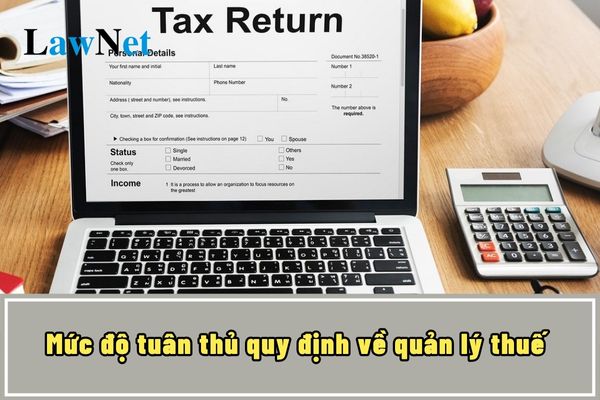What is the compliance level of tax administration regulations in Vietnam? What are requirements of Group 1 for evaluating compliance level of tax administration regulations in Vietnam?
What is the compliance level of tax administration regulations in Vietnam?
Pursuant to the regulations in Article 3 of Circular 31/2021/TT-BTC, the provisions are as follows:
Definitions
1. Application of risk management in tax administration refers to the implementation of procedural processes, principles, measures, and techniques for risk management and the results of tax law compliance evaluation, and the taxpayer's risk level to decide on the implementation of professional measures in tax administration.
2. Risk management information is tax-related information collected and processed to serve the application of risk management in tax administration.
3. Compliance level is the result of the tax authority's classification evaluation concerning taxpayers' adherence to the tax law.
4. Compliance evaluation criteria are standards used to evaluate taxpayers' compliance with the tax law.
5. Evaluation criteria indices are specific information indicators of the criteria used to evaluate taxpayers' compliance with the tax law.
6. Evaluation of tax law compliance involves collecting, analyzing, verifying, and comparing information on the operating process and compliance with tax law with the criteria and evaluation criteria indices to classify the compliance level of taxpayers.
...
Thus, based on the above regulation, the compliance level of tax administration regulations is the result of the tax authority's classification evaluation concerning taxpayers' adherence to the tax law.

What is the compliance level of tax administration regulations in Vietnam? Group 1 evaluates how the compliance level of tax administration regulations is required. (Image from the Internet)
What are the 7 steps for applying risk management to tax administration in Vietnam?
Based on Article 6 of Circular 31/2021/TT-BTC, the procadure of applying tax risk management is regulated as follows:
Step 1. Evaluate the situation, determine goals and risk management requirements
The tax authority reviews common risks and violations by taxpayers regarding the provisions of Article 17 of the 2019 tax administration Law or current regulations to identify major risks that need addressing and high-risk taxpayers along with appropriate solutions.
Step 2. Organize the collection and processing of risk management information
Risk management information is collected and processed as regulated in Chapter II of this Circular.
In cases where incorrect or incomplete declared information is detected during the risk analysis process, taxpayers are responsible for providing, explaining, or supplementing information and documents according to the tax authority's notifications to ensure accurate evaluation of tax law compliance and risk classification of taxpayers.
Step 3. Establish and update indicators to analyze and evaluate tax law compliance and classify taxpayer risk levels
Based on the results of the situation assessment, goal determination, and risk management requirements in Clause 1, Article 6 of Circular 31/2021/TT-BTC, risk management information, and information technology application to establish and update indicators criteria, weights used to evaluate, classify tax law compliance levels, and taxpayer risk levels.
Step 4. Analyze and evaluate tax law compliance levels; determine taxpayer risk levels; identify risks in tax administration operations; manage risk files for key monitoring cases
Taxpayers are segmented according to criteria that match tax administration requirements in each period when conducting the analysis and evaluation of tax law compliance and taxpayer risk levels.
The execution of the analysis and classification of tax law compliance levels and taxpayer risk levels is carried out using the methods outlined in Article 5 of Circular 31/2021/TT-BTC.
Step 5. Based on determined risk levels; evaluate the tax law compliance of taxpayers to apply tax administration measures and develop plans to enhance overall taxpayer compliance.
Step 6. Monitor, update, and evaluate feedback concerning the results of implemented tax administration measures.
Step 7. Collect, process, use, store information; direct and guide the adjustment and supplementation of the risk management application appropriately to ensure effective tax administration.
What are requirements of Group 1 for evaluating compliance level of tax administration regulations in Vietnam?
According to Annex 1, which lists the evaluation criteria for taxpayer law compliance issued with Circular 31/2021/TT-BTC, there are 6 groups of criteria evaluating taxpayer law compliance:
Group 1: Taxpayer operating status.
>>> Requirement: The taxpayer is active and not subject to a tax authority notice declaring the taxpayer non-operational at the registered address with the tax authority within two (02) years prior to the evaluation.
Group 2: Implementation of filing and payment of arising taxes as prescribed.
>>> Requirement: Filing and payment of arising taxes as prescribed within two (02) years prior to the evaluation.
Group 3: Compliance with policies on invoice and document management, usage.
>>> Requirement: Compliance with policies on invoice and document management, usage as prescribed within two (02) years prior to the evaluation.
Group 4: Administrative violations.
>>> Requirement: The taxpayer has been penalized for administrative violations regarding tax and invoices within two (02) years prior to the evaluation.
The taxpayer has been penalized for administrative violations concerning acts of tax deficiency, tax evasion within two (02) years prior to the evaluation.
The taxpayer has engaged in acts of using illegal invoices, illegal invoice usage within two (02) years prior to the evaluation.
The taxpayer was penalized by tax administration for non-compliance with tax inspection, tax audits, and enforcement of administrative tax decisions within two (02) years prior to the evaluation.
Group 5: Tax debt situation.
>>> Requirement: The amount of tax debt and the number of days late in paying tax debts at the time of evaluation.
Group 6: Other criteria group.
>>> Requirement: Other criteria as stipulated in related legal documents.

